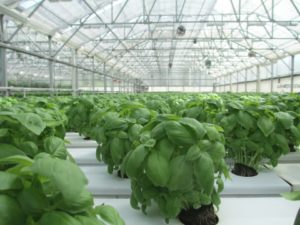Chlorfenapyr approved by the EPA for use on additional crops
Producers of greenhouse-grown vegetables and herbs have a new tool in the fight against thrips, mites and other insects thanks to efforts of the IR-4 Project.
 As resistance builds to pest management tools approved for use on basil, chives, cucumbers and small tomatoes grown in greenhouses, the U.S. Environmental Protection Agency (EPA) has approved the use of Chlorfenapyr, manufactured by BASF and sold as Pylon® miticide-insecticide, for use on these crops.
As resistance builds to pest management tools approved for use on basil, chives, cucumbers and small tomatoes grown in greenhouses, the U.S. Environmental Protection Agency (EPA) has approved the use of Chlorfenapyr, manufactured by BASF and sold as Pylon® miticide-insecticide, for use on these crops.
Chlorfenapyr targets key greenhouse insects including chilli thrips, Western flower thrips, rust mite, spider mite, cyclamen mite, lepidopteran larvae, fungus gnats and more. The pest management tool was already approved for greenhouse use on large tomatoes. By expanding its use on these additional crops, growers will have one more option for protecting their crops against pests.
“Chlorfenapyr is an oxidative phosphorylation uncoupler, which in layman’s terms means it disrupts part of the energy production cycle of the pest,” says Raymond Cloyd, Ph.D., professor in the Department of Entomology at Kansas State University. “It is the only registered product in the pyrroles class of chemistry. It’s really important to have a new mode of action to minimize resistance to other insecticides that are already available. We need to conserve the efficacy of those products, because there aren’t many new ones being developed. The cost of developing and bringing a new product to market and recouping that cost is very high. I tell growers that what they have in their toolboxes now is likely what they will have for the next five to 10 years.”
With this in mind, the value of the new approved use of Chlorfenapyr on additional greenhouse crops is clear.
The IR-4 Project conducted national research studies to determine the amount of Chlorfenapyr residue remaining on these crops. This data, along with data developed by Agriculture and Agri-Food Canada’s Pest Management Centre (PMC) on cucumbers, supported the pesticide tolerance and registration approval by the EPA.
Cloyd says the new use has been well received by growers. “Chlorfenapyr is labeled for many insect and mite pests including caterpillars, fungus gnats, broad mite, cyclamen mite, spider mites, and western flower thrips. And because it has a unique mode of action, it gives growers the ability to use it in a rotation program and conserve some of the other pesticides.”
Cloyd cautions growers to consult the label prior to using the product, as it is recommended to be used strategically as part of an integrated pest management approach.
“As with any pesticide, you need to use the product according to the label and be sure you know how it fits into your program, including your beneficial insects,” he says. “It’s great to have a new tool – just be sure to use it correctly.”
